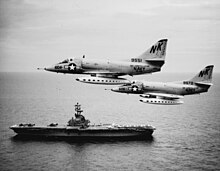Operation Pierce Arrow
In response to the Gulf of Tonkin incident when the destroyers USS Maddox and USS Turner Joy of the United States Navy engaged North Vietnamese ships, sustaining light damage[1] as they gathered electronic intelligence while in the international waters of the Gulf of Tonkin, U.S. President Lyndon B. Johnson ordered Operation "Pierce Arrow" which was conducted on 5 August 1964.
[2] The operation consisted of 64 strike sorties of aircraft from the aircraft carriers USS Ticonderoga and USS Constellation against North Vietnamese naval vessels (mostly Swatow gunboats--only two were torpedo boats) and the oil storage depot at Vinh.
Another, Lt. (jg) Everett Alvarez Jr.[3] an A-4 Skyhawk pilot, became the first U.S. Navy prisoner of war in Vietnam.
[5] Pilots estimated that the Vinh raid destroyed 10 percent of North Vietnam's entire petroleum storage, together with the destruction of or damage to 29 P-4 torpedo boats or gunboats.
The air operations following Pierce Arrow would swell so that by war's end, the United States bombing campaign was the longest and heaviest in history.
